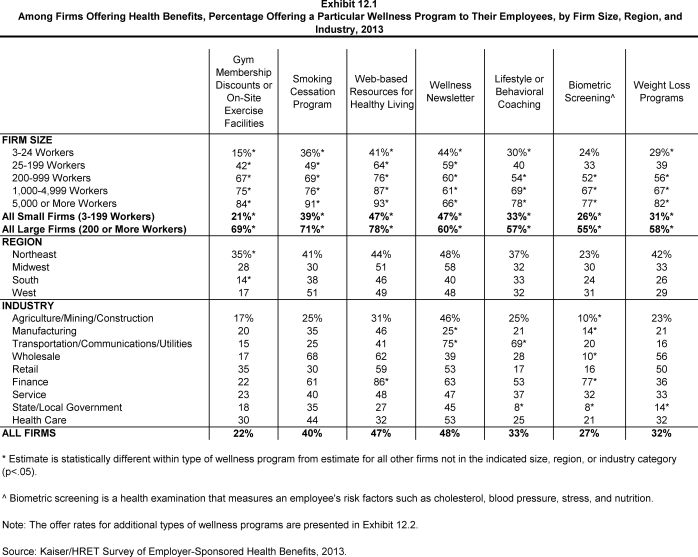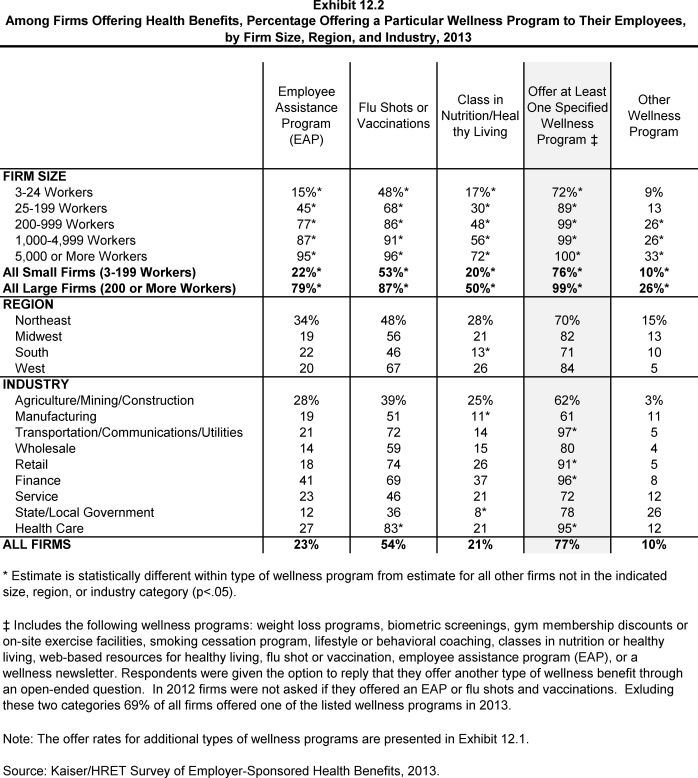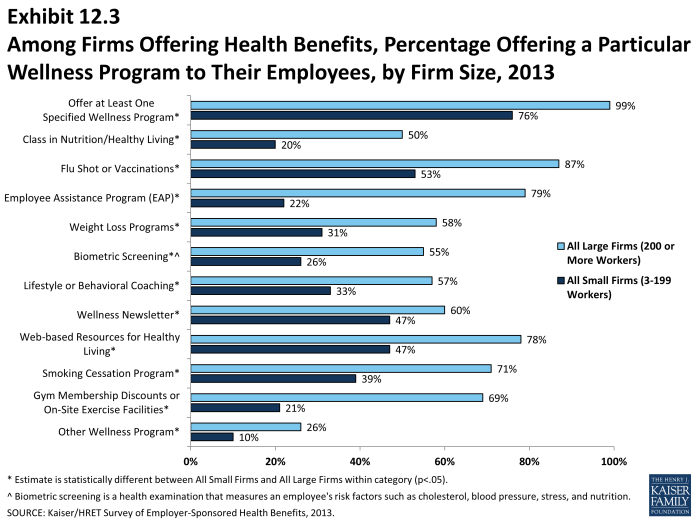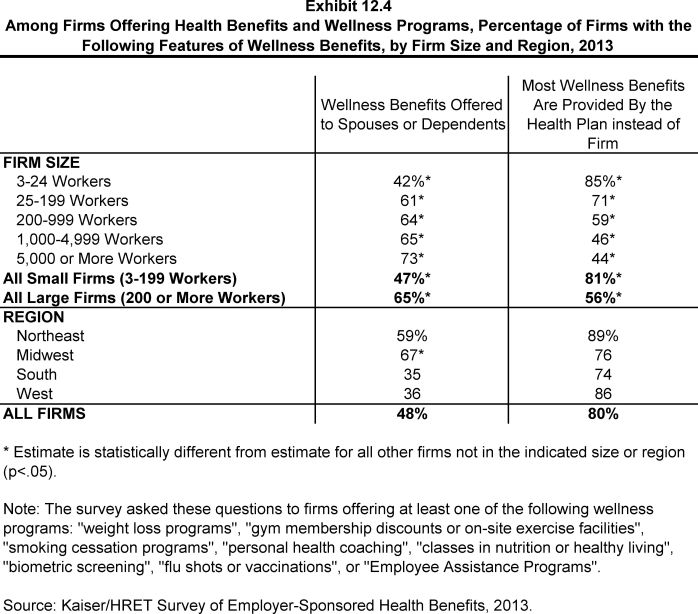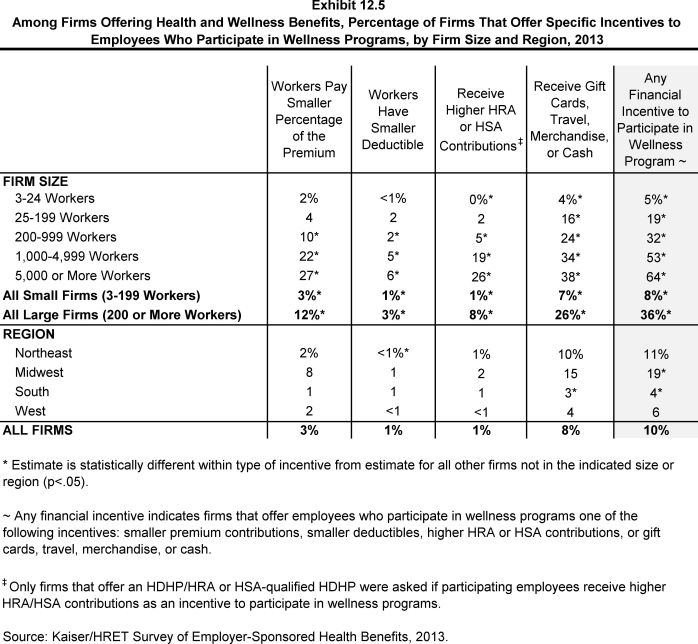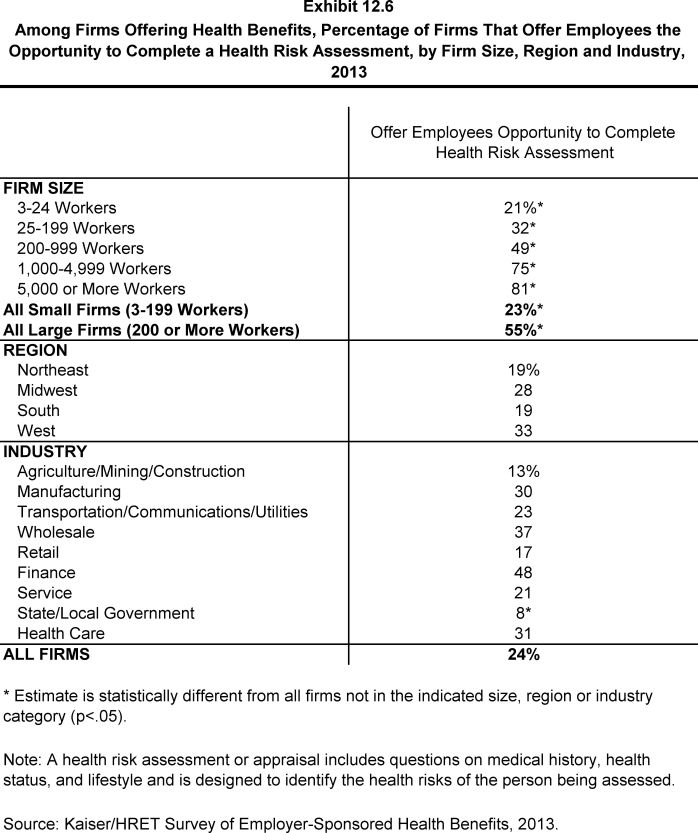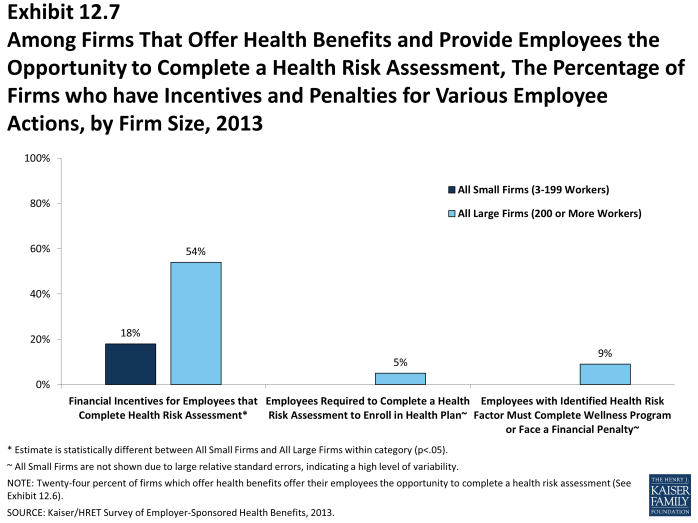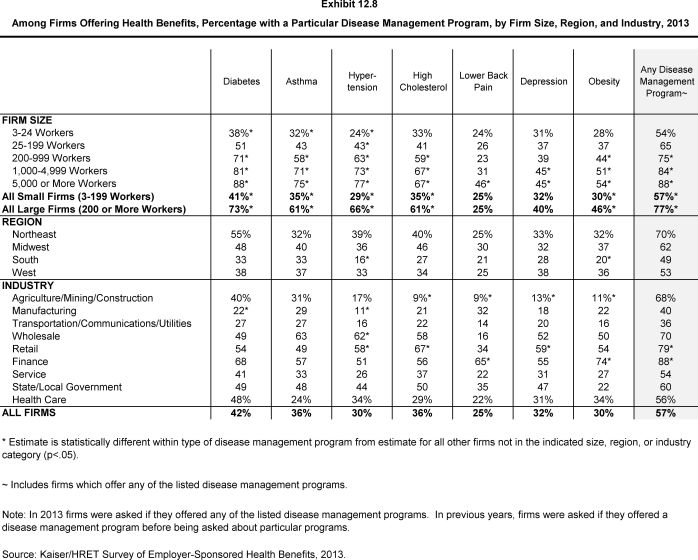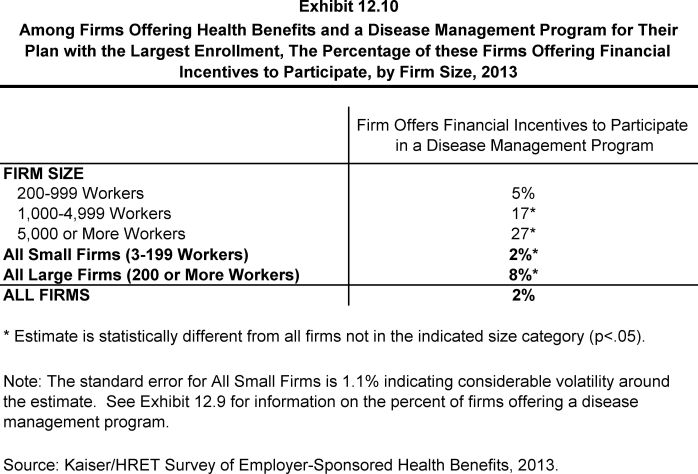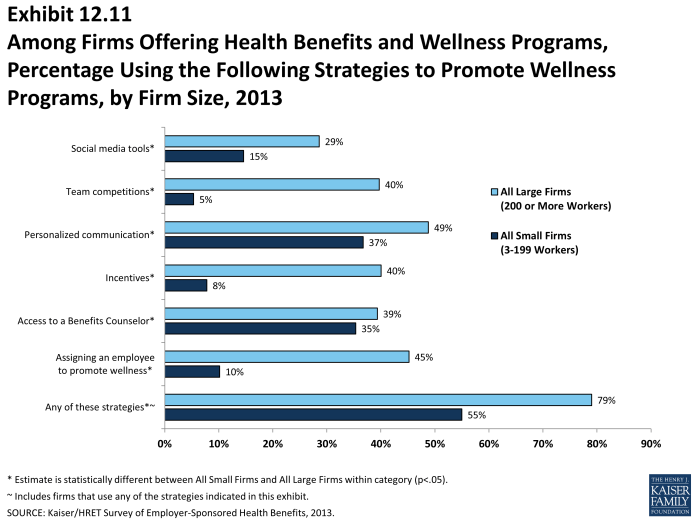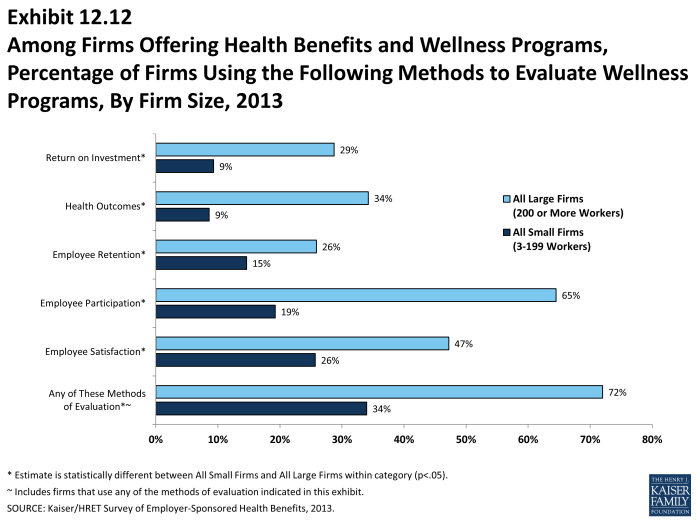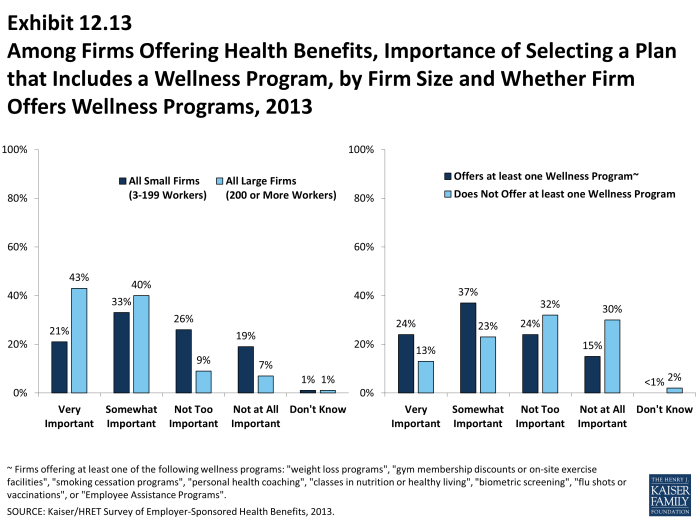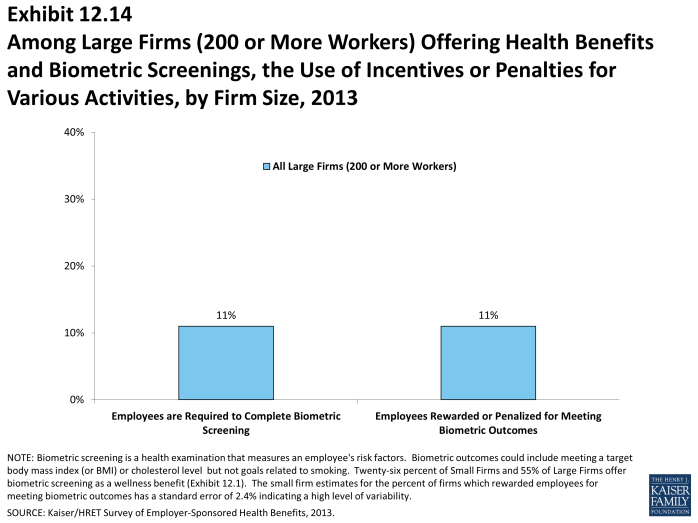2013 Employer Health Benefits Survey
Section Twelve: Wellness Programs and Health Risk Assessments
A majority of firms offering health benefits offers some type of wellness program, with large firms (200 or more workers) being more likely than smaller firms (3-199 workers) to do so. Thirty-six percent of large firms and 8% of small firms offering at least one wellness benefit offer financial incentives to employees who participate in wellness programs. Twenty-four percent of firms offer employees the opportunity to complete health risk assessments, with some of these firms tying financial penalties or rewards to employees who do so. Disease management programs remain common among firms offering health benefits with over half of these firms and more than three-quarters of large firms (200 or more workers) having at least one of the specified programs.
Wellness Benefits
- For a variety of reasons, including efforts to improve health and lower costs, many employers and health plans offer wellness programs. Wellness programs may range from classes in nutrition or healthy living to a wellness newsletter.
- Seventy-seven percent of firms offering health benefits offer at least one of the following wellness programs:
- Weight loss programs
- Biometric screenings
- Gym membership discounts or on-site exercise facilities
- Smoking cessation program
- Lifestyle or behavioral coaching, classes in nutrition or healthy living
- Web-based resources for healthy living
- Flu shot or vaccinations
- Employee assistance program (EAP)
- Wellness newsletter
- In the 2012 survey, offering firms were not asked if they offered an “EAP” or “flu shots and vaccinations”. Excluding these two categories, 69% of all firms offering health benefits also offered one of the listed wellness programs in 2013, similar to the amount in 2012 (63%).
- Large firms (200 or more workers) offering health benefits are more likely to offer each of the listed wellness programs than smaller firms. In addition, large firms (200 or more workers) offering health benefits are more likely to offer at least one of the listed wellness programs than smaller firms (99% vs. 76%) (Exhibit 12.2).
- About half of firms offering health benefits offer flu shots or vaccinations (54%), a wellness newsletter (48%) or web-based resources for healthy living (47%). The offer rate for each type of wellness benefit included in the survey is presented in (Exhibit 12.1), (Exhibit 12.2), and (Exhibit 12.3).
- Forty-eight percent of firms offering health benefits and at least one wellness benefit offer wellness benefits to spouses or dependents. Large firms (200 or more workers) offering at least one wellness benefit are more likely than smaller firms to offer wellness benefits to spouses or dependents (65% vs. 47%) (Exhibit 12.4).
- Among firms offering health benefits and at least one wellness program, 80% report that most of the wellness benefits they offer are provided by the health plan (Exhibit 12.4).1 Small firms (3 to 199 workers) are more likely than larger firms to report that most wellness programs are provided by the health plan (81% vs. 56%) (Exhibit 12.4).
Incentives for Wellness Benefits:
- In order to encourage participation in wellness programs, firms may offer financial incentives to employees who participate.2
- Eight percent of firms offering health benefits and at least one of the listed wellness programs offer gift cards, travel, merchandise, or cash to workers who participate in wellness programs. Large firms (200 or more workers) are more likely to offer these incentives than smaller firms (26% vs. 7%) (Exhibit 12.5).
- A small percentage of firms offering health benefits and at least one of the listed wellness programs offers lower worker premium contributions (3%) or cost sharing (such as lower deductibles) (1%) as an incentive to encourage employees to participate. Among firms that offer a high-deductible health plan paired with a HRA or HSA, one percent offers workers who participate in wellness programs higher HSA or HRA contributions (Exhibit 12.5).
- Employers use a variety of strategies to promote wellness programs. Large employers (200 or more employees) offering health benefits and at least one wellness program are more likely than smaller employers to use one of the following strategies to promote wellness (79% vs. 55%) (Exhibit 12.11):
- Assigning an employee to promote wellness
- Access to a benefits counselor
- Incentives
- Personalized communication
- Team competitions
- Social media tools
- Nearly half of large firms (200 or more workers) offering health benefits and at least one wellness program use personalized communication (49%) or assign an employee (45%) to promote wellness programs.
- Employers use a range of strategies to evaluate wellness programs. Seventy-two percent of large firms (200 or more workers) offering health benefits and at least one wellness program and 34% of smaller firms use at least one of the following evaluation methods (Exhibit 12.12):
- Return on investment
- Health outcomes
- Employee retention
- Employee participation
- Employee satisfaction
- For large firms (200 or more workers) offering health benefits and at least one wellness benefit, employee participation is the most common metric (65%) (Exhibit 12.12).
Health Risk Assessments
- Some firms give their employees the opportunity to complete a health risk assessment to identify potential health issues. Health risk assessments generally include questions about medical history, health status, and lifestyle.
- Overall, 24% of firms offering health benefits ask their employees to complete a health risk assessment. Large firms (200 or more workers) are more likely than smaller firms to offer employees this option (55% vs. 23%) (Exhibit 12.6).
- Some firms offer financial incentives to encourage employees to complete health risk assessments.
- Fifty-four percent of large firms (200 or more workers) offering health benefits and health risk assessments give financial incentives to employees who complete a health risk assessment.
- Five percent of large firms (200 or more workers) who offer health benefits and health risk assessments require employees to complete a health risk assessment in order to enroll in a health plan.
- Nine percent of large firms (200 or more workers) that offer health benefits and provide employees the opportunity to complete a health risk assessment penalize employees with identified health risks factors who do not complete a wellness program (9%) (Exhibit 12.7).
Biometric Screening
- Biometric screening is a health examination that measures an employee’s risk factors, such as cholesterol, blood pressure, stress, and nutrition. Biometric outcomes may include meeting a target body mass index (BMI) or cholesterol level. Twenty-six percent of small firms (3 to 199 workers) and 55% of larger firms offering health benefits offer biometric screenings as a wellness benefit (Exhibit 12.1).
- Firms which offer their employees biometric screenings may include additional incentives for those employees who complete screenings. Among large firms (200 or more workers) offering health benefits and biometric screenings, eleven percent reward or penalize employees for meeting biometric outcomes and eleven percent require employees to complete biometric screenings in order to enroll in a health plan (Exhibit 12.14).
Disease Management
- Disease management programs try to improve the health of and reduce the associated costs of people with chronic illnesses by teaching patients about their disease, suggesting treatment options, and assessing the treatment process and outcomes.
- Fifty-seven percent of firms offering health benefits offers one or more of the following disease management programs in their largest plan3 (Exhibit 12.8):
- Diabetes
- Asthma
- Hypertension
- High cholesterol
- Lower back pain
- Depression
- Obesity
- Large firms (200 or more workers) offering health benefits are more likely than smaller firms to have a disease management program (77% vs. 57%) (Exhibit 12.9). Seventy-three percent of large firms offering health benefits have a disease management program for diabetes.
- To encourage participation, two percent of firms offering health benefits and at least one of the specified disease management programs also offer financial incentives to employees who participate in these programs (Exhibit 12.10). Large, offering firms (200 or more workers) that offer disease management programs are more likely than smaller firms to have an incentive for participating in a disease management program (8% vs. 2%).

